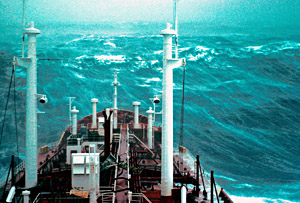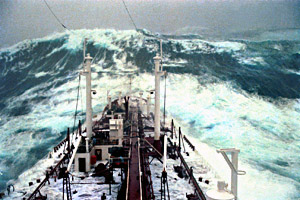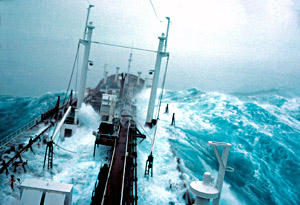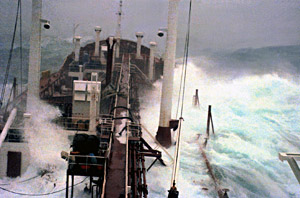The wind not only produces currents, it creates waves. As wind blows across the smooth water surface, the friction or drag between the air and the water tends to stretch the surface. As waves form, the surface becomes rougher, making it easier for the wind to push the water surface and intensify the waves.
Take it to the MAX! Anatomy of a Wave
Wind Waves
Wind waves are higher frequency waves generated near the wind source (frequency is the number of waves that pass a point in a specific amount of time). How big wind waves get depends on three things:
- Wind strength. The wind must be moving faster than the wave crests for energy to be transferred.
- Wind duration. Strong wind that blows for a long period will generate large waves.
- Fetch. This is the uninterrupted distance over which the wind blows without significant change in direction. (For example, storms of equal size can generate much larger waves in the open Pacific Ocean as compared to the other oceans due to the long open distance of water.)
After the wind has blown for a while, the waves get higher from trough to crest, and both the wavelength and period become longer. As the wind continues or strengthens, the water first forms whitecaps and eventually the waves start to break. This is referred to as a fully developed sea.
Take it to the MAX! Wind and Sea Scales
In the book Oceanography and Seamanship, William G. Van Dorn provided an example of what the wave heights would be if a steady 30 knot (33 mph/53 km/h) wind blew for 24 hours over a fetch of 340 miles.
- 10% of all waves will be less than 3.6 ft. (1 m).
- The most frequent wave height will be 8½ ft. (2½ m).
- The average wave height will be 11 ft. (3 m).
- The significant wave height will be 17 ft. (5 m).
- 10% of all waves will be higher than 18 ft. (5 m).
- The average wave height of the highest 10% of all waves will be 22 ft. (7 m).
- A 5% chance of encountering a single wave higher than 35 ft. (11 m) among every 200 waves that pass in about 30 minutes.
- A 5% chance of encountering a single wave higher than 40 ft. (12 m) among every 2,600 waves that pass in about five hours.
Swells
The waves in a fully developed sea outrun the storm that creates them, traveling great distances from the wind source and lengthening and reducing in height in the process. These lower frequency waves are called swell waves. Swells organize into groups smooth and regular in appearance. They are able to travel thousands of miles unchanged in height and period.
The longer the wave, the faster it travels. As waves leave a storm area, they tend to sort themselves out with the long ones ahead of the short ones, and the energy is simultaneously spread out over an increasingly larger area.
As the waves close in on the coast, they begin to interact with the bottom, and their direction of travel might change due to the contour of the land. Eventually, the waves run ashore, increasing up to 1.5 times their height in deep water, finally breaking up as surf.
Big wave surfing in Hawaii is possible because of swell waves generated from large winter Pacific Ocean storms from November through March.
Rogue Waves
There are many sailor tales of "rogue waves", "freak waves", "three sisters", and other "killer waves". Properly called "extreme storm waves", these tales were ridiculed, and mariners were accused of using them as an excuse to cover their own mistakes in wrecks. Rogue waves are simply unusually large waves appearing in a set of smaller waves.
Some of the characteristics of rogue waves are:
- Their height is greater than twice the size of surrounding waves,
- They often come unexpectedly from directions other than prevailing wind and waves and, most importantly,
- They are unpredictable.
Most reports of extreme storm waves say they look like "walls of water" and are seen as steep-sided with unusually deep troughs. The USS Ramapo reported one such wave with a height of 112 feet in the Pacific in 1933. Another report of a freak wave occurred when it struck the Queen Mary amidships, south of Newfoundland, at the end of World War II, rolling her to within a degree or two of capsizing.
In April 2005, a 70-foot wave crashed down on the Norwegian Dawn cruise ship. The average waves that day were 25 to 30 feet high before this monster wave struck. The wave even damaged the ship's hull.
What causes these enormous waves? Swells traveling across the ocean do so at different speeds and directions. As these swells pass through one another, their crests, troughs, and lengths happen to coincide and reinforce each other, combining to form unusually large waves which reach tremendous heights, then disappear. If the swells are traveling close to the same direction, these mountainous waves may last for several minutes before subsiding.
It is very seldom that huge waves over 65 feet (20 meters) develop, and normally sailors do not even see them because ships nowadays will try to avoid such conditions by altering course before the storm hits. But they do occur.
"Stolt Surf", North Pacific 1977
The following images are from the chemical tanker ship "Stolt Surf", built in 1970, caught in a large storm in the North Pacific Ocean. The largest waves of the storm broke over the Bridge, more than 72 feet (22 meters) high. Images © Karsten Petersen. Used by permission.






